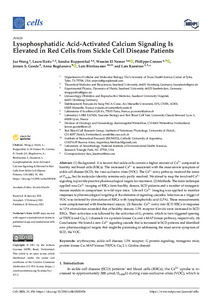Por favor, use este identificador para citar o enlazar este ítem:
https://repositorio.uca.edu.ar/handle/123456789/11619| Título: | Lysophosphatidic acid-activated calcium signaling is elevated in red cells from sickle cell disease patients | Autor: | Wang, Jue Hertz, Laura Ruppenthal, Sandra El Nemer, Wassim Connes, Philippe Goede, Jeroen S. Bogdanova, Anna Birnbaumer, Lutz Kaestner, Lars |
Palabras clave: | ENFERMEDAD DE CELULAS FALCIFORMES; ERITROCITOS; HISTOLOGIA; CALCIO; ANEMIA HEMOLITICA | Fecha de publicación: | 2021 | Editorial: | MDPI | Cita: | Wang, J., et al. Lysophosphatidic acid-activated calcium signaling is elevated in red cells from sickle cell disease patients [en línea]. Cells. 2021, 10 (2), 456. doi:10.3390/cells10020456. Disponible en: https://repositorio.uca.edu.ar/handle/123456789/11619 | Resumen: | Abstract: (1) Background: It is known that sickle cells contain a higher amount of Ca2+ compared to healthy red blood cells (RBCs). The increased Ca2+ is associated with the most severe symptom of sickle cell disease (SCD), the vaso-occlusive crisis (VOC). The Ca2+ entry pathway received the name of Psickle but its molecular identity remains only partly resolved. We aimed to map the involved Ca2+ signaling to provide putative pharmacological targets for treatment. (2) Methods: The main technique applied was Ca2+ imaging of RBCs from healthy donors, SCD patients and a number of transgenic mouse models in comparison to wild-type mice. Life-cell Ca2+ imaging was applied to monitor responses to pharmacological targeting of the elements of signaling cascades. Infection as a trigger of VOC was imitated by stimulation of RBCs with lysophosphatidic acid (LPA). These measurements were complemented with biochemical assays. (3) Results: Ca2+ entry into SCD RBCs in response to LPA stimulation exceeded that of healthy donors. LPA receptor 4 levels were increased in SCD RBCs. Their activation was followed by the activation of Gi protein, which in turn triggered opening of TRPC6 and CaV2.1 channels via a protein kinase C and a MAP kinase pathway, respectively. (4) Conclusions: We found a new Ca2+ signaling cascade that is increased in SCD patients and identified new pharmacological targets that might be promising in addressing the most severe symptom of SCD, the VOC. | URI: | https://repositorio.uca.edu.ar/handle/123456789/11619 | ISSN: | 2073-4409 | Disciplina: | MEDICINA | DOI: | https://doi.org/10.3390/cells10020456 | Derechos: | Acceso abierto | Fuente: | Cells Vol. 10, No. 2, 456, 2021 |
| Aparece en las colecciones: | Artículos |
Ficheros en este ítem:
| Fichero | Descripción | Tamaño | Formato | |
|---|---|---|---|---|
| lysophosphatidic-acid-activated-calcium.pdf | 4,53 MB | Adobe PDF |  Visualizar/Abrir |
Visualizaciones de página(s)
101
comprobado en 27-abr-2024
Descarga(s)
88
comprobado en 27-abr-2024
Google ScholarTM
Ver en Google Scholar
Altmetric
Altmetric
Este ítem está sujeto a una Licencia Creative Commons

